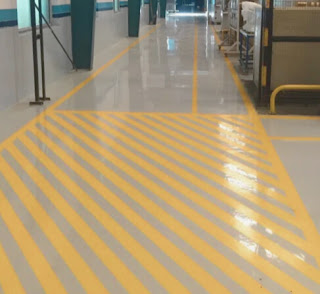What Is Epoxy Flooring? Everything You Need to Know Before Installation
If you're planning a renovation or need a durable surface for your commercial or industrial space, an epoxy floor covering could be the ideal solution. Known for its strength, aesthetics, and resistance to wear, epoxy flooring has become a popular choice in garages, warehouses, retail stores, and even homes. But what exactly is it, and what should you know before installing it?
This guide explains everything about epoxy floor covering, from how it works to its benefits, drawbacks, and installation process.
What Is Epoxy Flooring?
Epoxy flooring is a type of resin-based floor coating that is applied over concrete surfaces. It is made by mixing epoxy resin with a hardener, which chemically reacts to form a strong, durable plastic material. This creates a smooth, high-gloss surface that adheres tightly to the concrete substrate beneath it.
A standard epoxy floor covering includes multiple layers:
-
Primer – Prepares the concrete and ensures better adhesion.
-
Base coat – The main layer, typically colored or enhanced with decorative flakes or metallic pigments.
-
Topcoat – A clear, protective layer that increases resistance to scratches, chemicals, and UV rays.
When cured, an epoxy floor becomes a solid, seamless surface that is resistant to most forms of damage.
Benefits of Epoxy Floor Covering
1. Long-Lasting Durability
One of the top reasons people choose epoxy floor covering is its durability. These floors can last over 10 years with minimal upkeep, especially in industrial or high-traffic environments. They’re resistant to abrasion, impact, and even chemical spills, making them ideal for workshops and garages.
2. Easy Maintenance
Thanks to its seamless surface, cleaning an epoxy floor covering is as simple as sweeping or mopping. It resists stains, oils, and dust, which is why it’s often used in environments that demand high cleanliness like commercial kitchens, hospitals, and showrooms.
3. Aesthetic Appeal
Epoxy flooring isn’t just functional—it’s also attractive. From metallic finishes to decorative flakes, there are countless customization options. Businesses often incorporate their logos or brand colors directly into the epoxy floor covering for a sleek, branded look.
4. Moisture and Chemical Resistance
Epoxy coatings create a waterproof barrier that protects concrete floors from moisture intrusion, corrosion, and chemical damage. This feature makes epoxy floor covering suitable for basements, garages, and even commercial car washes.
5. Cost-Effective Over Time
Although the initial installation cost may be higher than regular floor paint, the long life and low maintenance requirements make epoxy floor covering a smart long-term investment.
Potential Drawbacks to Consider
While epoxy flooring has many advantages, it’s important to understand its limitations:
-
Slippery when wet – Unless additives like sand or grit are included, a smooth epoxy floor covering can become slippery.
-
Time-consuming prep – Proper surface preparation is essential. Poor preparation can lead to bubbles, peeling, or failure to bond.
-
Curing time – Depending on the temperature and type of epoxy, floors can take 24 to 72 hours to fully cure.
-
Not suitable for all surfaces – It must be installed over clean, dry, structurally sound concrete. It’s not ideal for wood, tiles, or damp areas unless treated with moisture barriers.
Preparing for Installation
Proper preparation is critical for a successful epoxy floor covering installation. Here's a step-by-step overview:
1. Inspect and Repair the Concrete
Before applying epoxy, any existing cracks, oil stains, or surface damage must be repaired. Moisture tests should also be conducted to prevent future peeling.
2. Surface Grinding or Etching
The concrete must be roughened either by diamond grinding or acid etching. This improves bonding between the concrete and the epoxy floor covering.
3. Priming and Base Coating
An epoxy primer is applied first. This helps the main layer adhere better. After the primer cures, the base coat is applied. It may be enhanced with decorative flakes, color pigments, or anti-slip agents.
4. Topcoat Application
A high-quality topcoat seals the floor and adds UV and chemical resistance. It also creates the signature glossy finish of an epoxy floor covering.
5. Curing and Aftercare
Curing times vary, but it's best to wait at least 24 hours before walking on the surface and 72 hours before parking vehicles.
Is Epoxy Floor Covering Right for You?
Epoxy flooring is ideal for a wide variety of environments, but it's not suitable for every application. Here's a quick breakdown:
Best for:
-
Garages and driveways
-
Warehouses and factories
-
Retail stores and showrooms
-
Commercial kitchens and hospitals
-
Basements and utility rooms
Less ideal for:
-
Outdoor areas without UV protection
-
Wooden or soft subfloors
-
Areas with consistent water exposure, like showers
If your space meets the right conditions, epoxy floor covering offers excellent value, performance, and style.
Final Thoughts: An epoxy floor covering is a reliable, attractive, and versatile flooring solution that’s well-suited to both residential and commercial applications. It delivers unmatched durability, chemical resistance, and visual appeal—while offering long-term cost savings thanks to its low maintenance needs.
However, the success of your project depends on careful surface preparation, quality materials, and proper installation. Whether you’re upgrading your garage or renovating a commercial space, understanding the full picture of what epoxy flooring offers will help you make the right choice.



Comments
Post a Comment